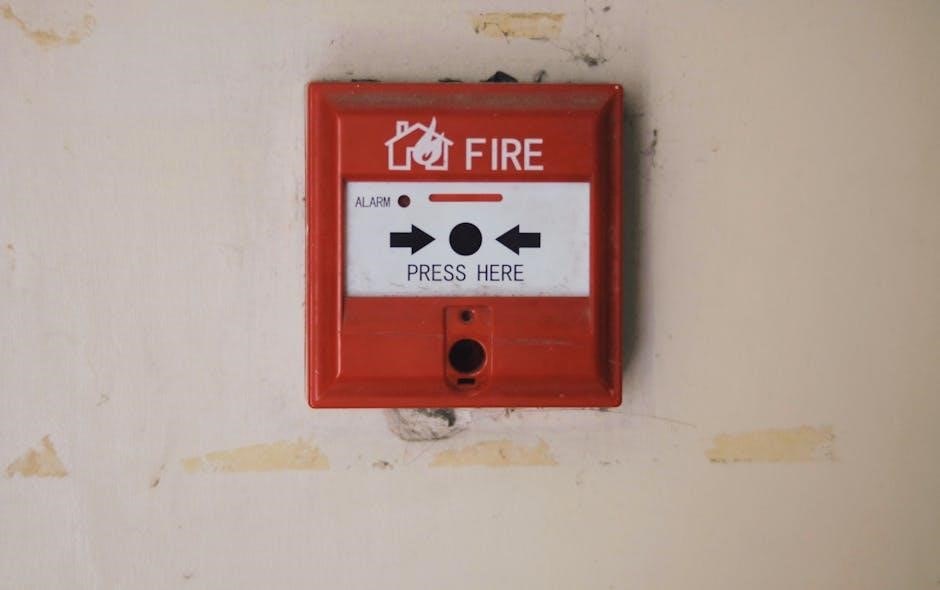The DSC alarm system offers cutting-edge security solutions‚ designed for residential and commercial use‚ providing advanced protection through innovative control panels and wireless technologies․
1․1 Overview of the DSC Alarm System
The DSC alarm system is a comprehensive security solution designed to protect homes and businesses․ It features advanced control panels‚ such as the PC1616‚ PC1832‚ and PC1864‚ which offer multi-zone control and wireless capabilities․ The system integrates sensors‚ detectors‚ and keypads‚ providing robust intrusion detection and alert mechanisms․ With customizable settings and integration options‚ DSC systems ensure enhanced security and user convenience‚ making them a reliable choice for modern security needs․
1․2 Importance of the User Manual
The user manual is essential for understanding and utilizing the DSC alarm system effectively․ It provides step-by-step guidance for installation‚ operation‚ and troubleshooting‚ ensuring users can maximize system features․ The manual covers arming/disarming procedures‚ zone management‚ and error resolution‚ helping users maintain security and resolve issues promptly․ Regularly referencing the manual ensures optimal system performance and user confidence in managing their security setup efficiently․
Understanding the System Components
The DSC alarm system comprises control panels‚ keypads‚ sensors‚ and detectors‚ each playing a critical role in ensuring security and efficiency․ Understanding these components is vital for optimal functionality․
2․1 Control Panels (PC1616‚ PC1832‚ PC1864)
The DSC PC1616‚ PC1832‚ and PC1864 control panels are central to the alarm system‚ offering multi-zone security solutions․ These panels support up to 16‚ 32‚ and 64 zones‚ respectively‚ catering to various property sizes․ They feature advanced programming options‚ hybrid wired-wireless capabilities‚ and seamless integration with accessories like keypads and sensors․ Designed for reliability‚ these panels ensure robust security‚ making them ideal for both residential and commercial applications․
2․2 Keyboards and Keypads (LCD 5500 Keypad)
The LCD 5500 Keypad is a user-friendly interface for controlling the DSC alarm system․ Featuring a clear LCD display‚ it provides real-time system status‚ zone information‚ and user prompts․ The keypad’s intuitive button layout allows for easy arming‚ disarming‚ and troubleshooting․ Compatible with DSC control panels‚ it enhances system accessibility and simplifies operation‚ making it an essential component for seamless security management․
2․3 Sensors and Detectors
DSC systems utilize a variety of sensors and detectors to ensure comprehensive security coverage․ These include motion detectors‚ door and window contacts‚ glass break sensors‚ and smoke detectors․ Each sensor is designed to detect specific threats‚ triggering alerts and alarms to notify users of potential breaches․ With reliable and precise detection capabilities‚ these devices are integral to the overall functionality and effectiveness of the DSC alarm system in protecting properties and assets․

Installation and Setup
Proper installation and setup of the DSC alarm system ensure optimal performance and security․ This involves preparing the site‚ connecting components‚ and conducting thorough testing to verify functionality․
3․1 Preparing the Site
Preparing the site for DSC alarm system installation involves assessing the property’s layout and ensuring all areas are accessible for component placement․ Identify power sources and internet connectivity points for control panels and keypads․ Clear obstructions to avoid signal interference and plan sensor placements strategically․ Verify compatibility of existing infrastructure with DSC components․ Proper site preparation ensures smooth installation and optimal system performance‚ minimizing potential issues during setup and operation․
3․2 Connecting Components
Connect the control panel to keypads‚ sensors‚ and detectors using compatible wiring or wireless modules․ Ensure all wires are securely attached to the correct terminals on the control panel․ Test each connection to verify proper functionality․ For wireless devices‚ sync them with the control panel following the manufacturer’s pairing instructions․ Double-check all connections to avoid system malfunctions․ Properly connecting components ensures reliable performance and accurate alarm responses during potential security breaches․
3․3 Initial System Testing
After installation‚ perform a comprehensive system test to ensure all components function correctly․ Trigger each sensor to verify alarm activation and proper zone identification․ Test arming and disarming processes to confirm responsiveness․ Check communication with monitoring services if applicable․ Review system logs for any errors or issues․ Address any malfunctions promptly to guarantee optimal security coverage․ Testing ensures the system is ready to provide reliable protection and peace of mind for users․

Basic Operations
Understand essential functions like arming‚ disarming‚ and menu navigation to use the system effectively․ These operations ensure smooth daily interaction with your security setup for optimal protection․
4․1 Turning the System On/Off
To arm the system‚ enter your user code followed by the “Away” or “Stay” button․ Disarm by re-entering your code․ Ensure all zones are secure before arming in Away mode․ Remember to test the system regularly to confirm proper functionality․ Always keep your user code confidential for security․ Refer to your manual for specific keypad sequences and additional options like quick arming features․ Properly managing these operations ensures your system provides reliable protection for your property․ Regular checks help maintain system efficiency and effectiveness․
4․2 Navigating the Keypad Menu
Navigate the DSC keypad menu by using the arrow keys to scroll through options․ Press [*] to access the main menu and [1] for system status․ Use [→] and [←] to move between menu items‚ and [OK] to select․ The LCD display guides you through each function; To exit‚ press [#]․ Familiarize yourself with shortcut keys for quick access to frequently used features․ Always refer to your user code for secure access to certain menu options․ Regular practice ensures smooth operation of your security system․

Arming and Disarming the System
Arm and disarm your DSC system using your user code․ Enter the code to activate or deactivate protection․ Ensure the system is ready before arming․ Familiarize yourself with the process for reliable security․
5․1 Arming in Away Mode
Arm your DSC system in Away Mode when leaving the premises․ This mode activates all sensors and triggers alarms if unauthorized access occurs․ Enter your code‚ press the Away button‚ and exit the delay time․ The system will confirm arming with a beep or display message․ Away Mode offers full protection‚ ensuring security while you’re away․ Always ensure all doors and windows are closed before arming․
5․2 Arming in Stay Mode
Arm your DSC system in Stay Mode when remaining on the premises․ This mode activates perimeter sensors while allowing free movement indoors․ Enter your code‚ press the Stay button‚ and wait for confirmation․ The system will protect all exterior zones but not interior zones‚ ensuring security while you stay inside․ Stay Mode is ideal for nighttime or when occupants are present but want to maintain a secure environment․ Ensure all doors and windows are closed before arming․
5․3 Disarming the System
To disarm the DSC system‚ enter your valid user code using the keypad․ Press the “Disarm” button or the “#” key‚ depending on your system․ The alarm will stop sounding‚ and the panel will return to ready mode․ Ensure all zones are secure before disarming․ If prompted‚ confirm disarm by re-entering your code․ Disarming deactivates all sensors‚ allowing free movement without triggering alarms․ Always verify the system status on the keypad display after disarming․
Special Modes
The DSC system offers Night Mode for enhanced security while you sleep and Guest Mode to accommodate visitors without triggering alarms‚ ensuring tailored protection for different scenarios․
6․1 Night Mode
Night Mode enhances security while you sleep‚ arming interior sensors and monitoring movement․ Activate it via keypad or remote‚ ensuring perimeter protection without false alarms․ LEDs indicate status clearly․
6․2 Guest Mode
Guest Mode allows temporary access for visitors without compromising security․ Users can create limited-access codes‚ restricting guests to specific areas․ This mode enhances convenience while maintaining system integrity and user control․

Troubleshooting Common Issues
Troubleshooting involves identifying error codes and resolving system faults․ Regular checks and restarts help maintain functionality and ensure reliable performance․
7․1 Identifying Error Codes
Error codes on the DSC alarm system indicate specific issues‚ such as hardware malfunctions or connectivity problems․ Codes like “12” may signal a power failure‚ while “24” could indicate communication issues․ Refer to the user manual or the system’s display for code meanings․ Troubleshooting often involves checking the control panel‚ sensors‚ or network connections․ Regular system checks can help prevent errors and ensure reliable performance․
7․2 Resolving Common Faults
Common faults in the DSC alarm system often relate to sensor malfunctions or communication issues․ Check sensor alignment and ensure all wires are securely connected․ For keypad errors‚ restart the system or replace the battery if necessary․ If a “Check 100” error appears‚ inspect zone wiring for damage or short circuits․ Refer to the user manual for specific troubleshooting guides tailored to your system model․ Regular maintenance can help prevent recurring faults and ensure optimal performance․
7․3 System Restart and Reset
To restart the DSC alarm system‚ ensure it is disarmed․ Enter your master code followed by 7 to reset․ This clears all faulted zones and restores default settings․ For a full system reset‚ power down the control panel‚ wait 30 seconds‚ and restart․ After resetting‚ re-arm the system to ensure proper functionality․ Always confirm the reset with the system’s confirmation tone or message to ensure the process was successful․

User Customization
The DSC system allows users to customize settings‚ such as user codes and system preferences‚ to tailor security to their specific needs and enhance protection․
8․1 Setting User Codes
Setting user codes on the DSC system allows for personalized security access․ Enter the master code‚ navigate to the programming menu‚ and assign unique codes to each user․ Ensure codes are complex for enhanced security․ Codes can be updated or deleted as needed․ This feature ensures only authorized individuals can arm or disarm the system‚ providing an additional layer of protection and control over system access․
8․2 Adjusting System Settings
Adjusting system settings on the DSC alarm system allows customization to meet specific security needs․ Users can modify zone configurations‚ entry/exit delays‚ and chime modes via the keypad․ Access the programming menu by entering the master code‚ then navigate to the desired settings․ Changes are saved automatically‚ ensuring personalized security preferences․ Regularly review and update settings to maintain optimal system performance and adapt to changing security requirements;
Maintenance and System Care
Regular maintenance ensures optimal performance of the DSC alarm system․ Perform system checks‚ test sensors‚ and inspect batteries to maintain reliability and security effectiveness․
9․1 Regular System Checks
Regular system checks are essential for maintaining your DSC alarm system’s functionality․ Schedule periodic inspections of all components‚ including sensors‚ keypads‚ and control panels‚ to ensure they are operational․ Test each zone and verify that all sensors are correctly reporting their status․ Additionally‚ check system logs for any error codes or unusual activity․ Addressing issues promptly prevents potential security breaches and ensures continuous protection for your property․ Proper maintenance also extends the lifespan of your security equipment․
9․2 Battery Maintenance
Regular battery maintenance ensures your DSC alarm system remains reliable․ Check the standby battery in the control panel every 6 months‚ and replace it if weak or outdated․ Test the battery by simulating a power outage to confirm the system stays operational․ Always use the recommended battery type for optimal performance․ Replace batteries promptly when the system alerts you to low levels․ Proper battery care prevents false alarms and guarantees continuous security coverage․

Advanced Features
The DSC system offers advanced features like zone management‚ access control integration‚ and compatibility with home automation‚ enhancing security and user convenience seamlessly․
10․1 Zone Management
Zone management in the DSC alarm system allows users to define and customize multiple zones within their property․ Each zone can be configured to monitor specific areas‚ such as doors‚ windows‚ or motion detectors‚ providing precise control over security settings․ Users can assign unique names to zones for easy identification and adjust sensitivity levels to minimize false alarms․ This feature enhances system flexibility‚ enabling tailored security solutions for different parts of a property‚ ensuring comprehensive protection and user convenience․
10․2 Access Control Integration
The DSC alarm system seamlessly integrates with access control solutions‚ enabling advanced user management and secure entry points․ This feature allows for keycard‚ biometric‚ or keypad access‚ ensuring only authorized individuals can enter restricted areas․ Users can assign specific permissions‚ monitor access events in real-time‚ and generate reports for auditing purposes․ This integration enhances overall security by combining intrusion detection with controlled access‚ providing a comprehensive solution for managing who‚ when‚ and where access is granted within a property․

Integration Capabilities
The DSC alarm system supports integration with home automation systems‚ IP monitoring products‚ and other security technologies‚ offering a comprehensive and interconnected security solution for enhanced protection and convenience․
11․1 Home Automation Integration
The DSC alarm system seamlessly integrates with home automation systems‚ enabling users to control lighting‚ thermostats‚ and door locks through a unified interface․ This integration enhances security by allowing automated responses to system events‚ such as turning on lights when motion is detected․ Compatibility with popular systems like Z-Wave and Zigbee ensures a smooth setup‚ offering a convenient and efficient way to manage both security and home automation from a single platform․
11․2 Compatibility with Other Systems
The DSC alarm system is designed to integrate with various third-party devices and systems‚ ensuring enhanced functionality and versatility․ It supports compatibility with smart home technologies like Z-Wave and Zigbee‚ enabling seamless control of lighting‚ HVAC‚ and door locks․ Additionally‚ DSC systems can integrate with IP monitoring services and home automation platforms‚ offering a unified security and convenience experience․ This flexibility makes the system adaptable for both residential and commercial applications‚ ensuring robust security and efficient operation․

Monitoring and Remote Access
The DSC system offers remote monitoring through mobile apps‚ enabling users to receive alerts‚ arm/disarm the system‚ and view live status updates from anywhere․
12․1 Remote Monitoring Setup
Setting up remote monitoring for your DSC alarm system involves enabling internet connectivity and configuring the system with your mobile app․ Ensure your control panel is connected to a stable internet source․ Download and install the compatible mobile app‚ then log in using your system credentials․ Enable remote access features through the app settings․ Once configured‚ you can monitor your system‚ receive real-time alerts‚ and control arming/disarming from anywhere․ Refer to your user manual for specific app and connectivity requirements․
12․2 Using Mobile Apps
Mobile apps like DSC’s dedicated software enable seamless control and monitoring of your alarm system․ Users can arm/disarm the system‚ view live status‚ and receive notifications for events․ Key features include real-time alerts‚ zone management‚ and system customization․ Ensure your app is updated for optimal performance and security․ Refer to your manual for app compatibility and setup instructions to enhance your system’s functionality and accessibility․

Compliance and Standards
DSC systems comply with global security regulations and certifications‚ ensuring reliability and safety․ They meet industry standards for electronic security‚ backed by Tyco Security Products’ expertise․
13․1 Security Regulations
DSC alarm systems adhere to strict global security regulations‚ ensuring compliance with industry standards․ They meet EN Grade 3 requirements for intrusion alarm systems‚ making them suitable for high-security applications․ These systems are designed to align with local and international security laws‚ providing users with reliable protection․ Compliance is verified through rigorous testing and certification processes‚ guaranteeing that DSC systems deliver trusted performance for both residential and commercial security needs․
13․2 System Certification
DSC alarm systems are certified to meet global security standards‚ ensuring reliability and performance․ They hold certifications such as UL (Underwriters Laboratories) and EN Grade 3‚ confirming adherence to strict industry requirements․ These certifications are obtained through rigorous third-party testing‚ verifying the system’s robustness and compliance with security protocols․ Certified systems provide users with assurance of quality‚ safety‚ and effectiveness‚ making them trusted solutions for securing properties and assets․
Upgrading the System
Regular system upgrades ensure enhanced security and functionality․ Firmware updates and adding new components can be performed to maintain optimal performance and compatibility with the latest features․
14․1 Firmware Updates
Regular firmware updates are essential for maintaining the DSC alarm system’s performance and security․ These updates enhance functionality‚ fix bugs‚ and ensure compatibility with the latest features․ To update‚ connect the control panel to a computer or use a secure network connection․ Follow the manufacturer’s instructions to download and install the latest firmware version․ Always verify the update source to prevent unauthorized access․ After installation‚ test the system to ensure all components operate correctly․ Updated firmware ensures optimal system operation and advanced security capabilities․
14․2 Adding New Components
Expanding your DSC alarm system is straightforward with compatible components like sensors‚ keypads‚ or cameras․ Ensure new devices are compatible with your control panel model․ Power down the system before installation․ Connect the component to the panel or network‚ following the manufacturer’s wiring or wireless pairing instructions․ Enable the new device in the system settings and test its functionality; Always consult the user manual or contact support for complex integrations to ensure seamless system operation and security․ Proper installation ensures enhanced protection and system efficiency․
The DSC alarm system offers a comprehensive security solution‚ combining advanced features with user-friendly operation․ By following this manual‚ users can effectively navigate installation‚ customization‚ and troubleshooting․ Regular maintenance and updates ensure optimal performance․ For enhanced security‚ always refer to the manual or contact support for assistance․ With proper use‚ the DSC system provides reliable protection and peace of mind for years to come․
